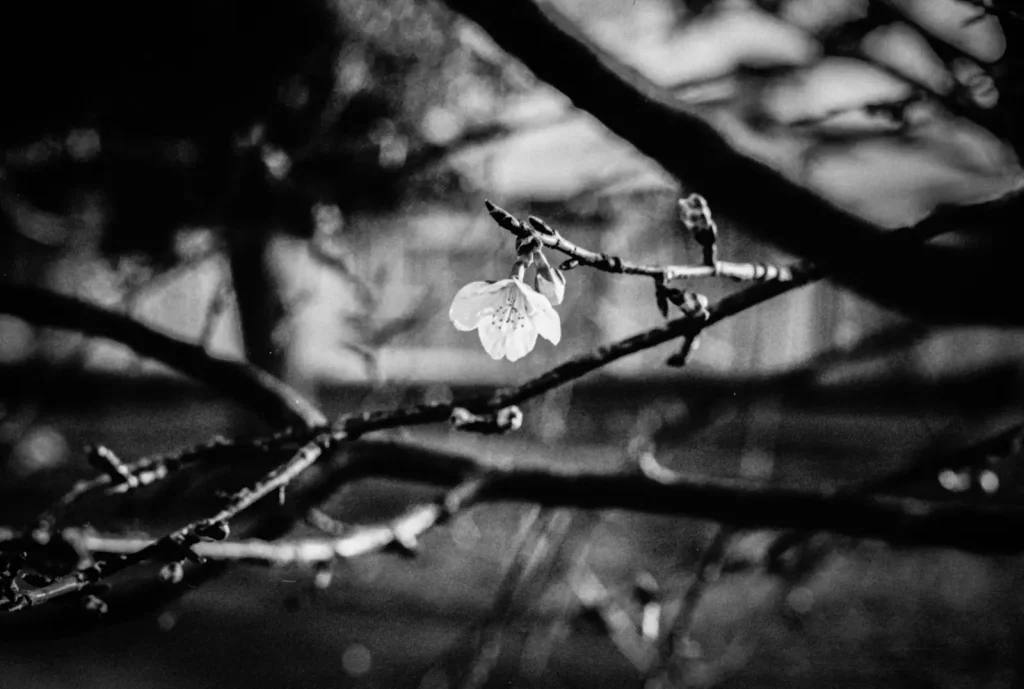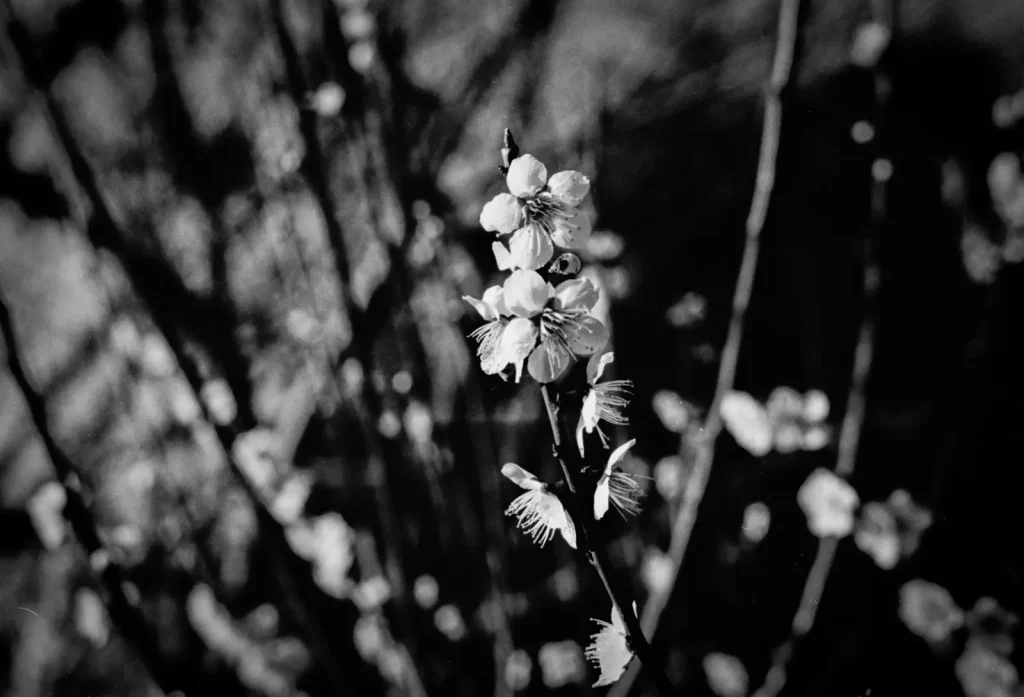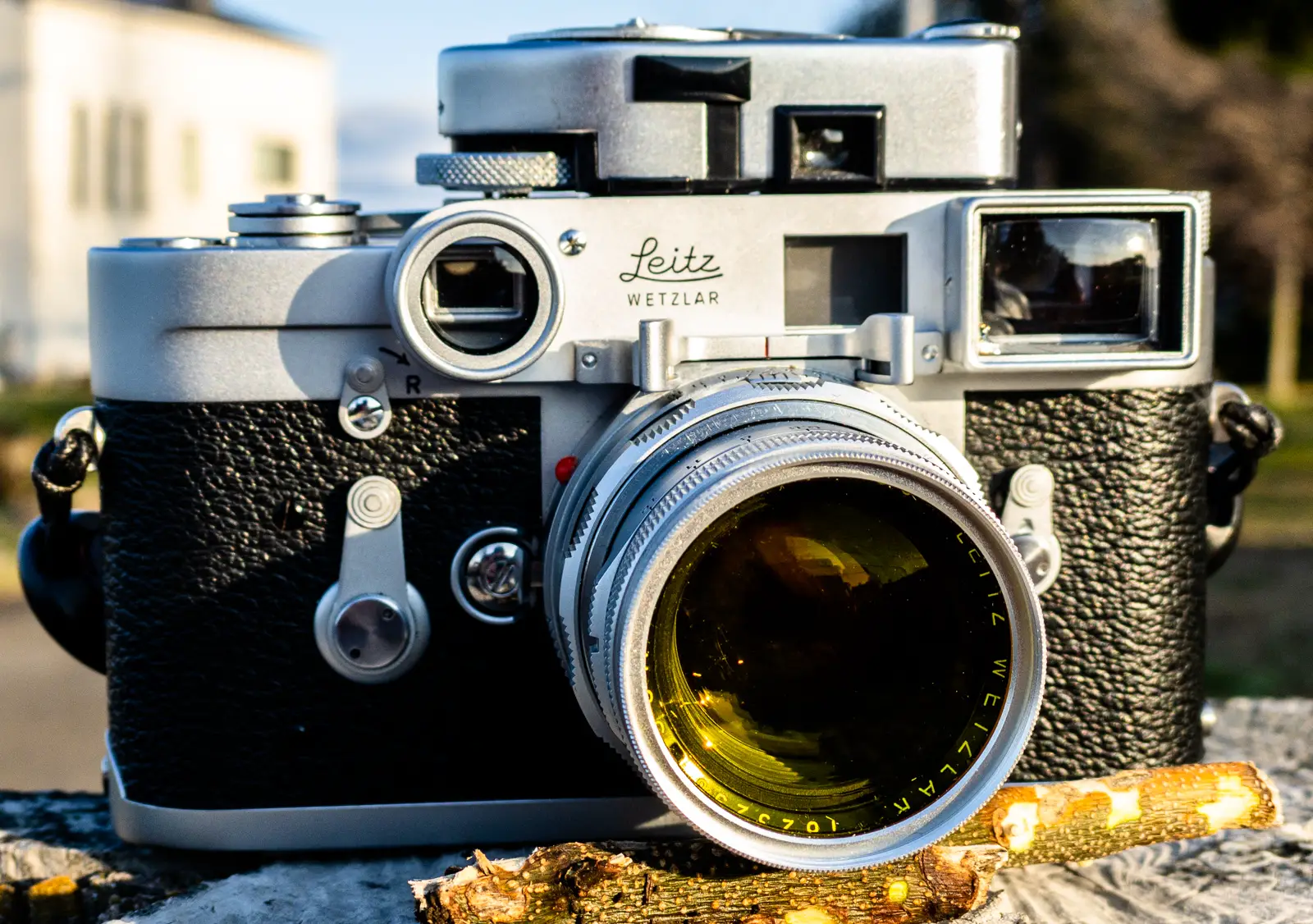About a month before Japan’s world-famous cherry blossom season in late March, is the lesser-known plum blossom season in late February. Plum blossoms in Japan are the first hint of the coming spring, and while not as explosively striking as cherry blossoms and the warming weather than accompanies them, plum blossoms are enough to attract Japanese for plum blossom viewing if not tourists from overseas. There are some famous Japanese gardens for viewing plum blossoms in Ibaraki Prefecture where I live, like the Mount Tsukuba Bairin and Kairakuen in Mito, the prefectural capital, but I don’t need to travel too far from my front door to see plum blossoms, as there are many plum trees in my own neighborhood, and these make excellent subjects for photography.

When I bought my first Leica M3, one of the first lenses I bought for it was a 1950s era Summicron Dual Range 50mm f/2—’dual range’ because it has attachable optics that allow for shooting subjects up close, from just under 50cm up to 90cm as opposed to the standard minimum range on the lens from one meter. As far as I know, no other Leica Summicron 50mm f/2 allows for focal distance from 50cm, although later versions of the lens do allow for shooting from 70cm rather than one meter.
The Summicron DR is often considered the Summicron 50mm to go for when on a budget. It sells for substantially less than later Summicron models and even its non-DR sibling which sold contemporaneously. There is a reason for that. First, the Summicron DR is heavy, and if you check Ken Rockwell’s excellent comparison of Summicron 50s, the DR weighs in at a whopping 339g, the heaviest Summicron 50mm of them all. But what can you say? Brass is heavy.

And then there is a design flaw that precludes mounting a Summicron DR on a Leica digital camera like the M9, M240, and M10—the only Leica M-mount lens I know of that won’t click into place if you try to mount it on the digital Leica M cameras—which in any case I don’t recommend trying for yourself! If you do, definitely do not force the lens, or you will do serious damage camera body, the lens, or both!
Even non-recommended lenses like the collapsible Elmar 50mm f/2.8, 1950s and its later versions, will still mount on a Leica digital M camera. Just don’t collapse it while mounted like you would on an analog Leica M, or you risk damage. The 1960s era Leica Super Angulon 21mm f/4 will mount on a digital Leica M. However, the rear element sits far enough into the body as to mess with the light meter. So, it is only the Summicron DR that turns its nose up at a digital Leica M like a cranky Leica film camera purist!

That being said, as long as it is an analog Leica M that you want to use, the Summicron DR is fine. Even though it was designed for the M3, it works fine on the M4, the M6, the M7 even with the optics, and presumably with the M2, M5, MP and M-A. As for lens quality, you won’t get the extreme sharpness of later versions of the Summicron 50mm, but who cares? On film, it is hard to distinguish the results between the DR and its progeny, and sharpness really does not matter that much most of the time, unless you are into spy plane photography. I’m not.

If you use the DR without the optics, it works just like a regular Summicron. In fact most of the time you find a Summicron DR for sale, it is sans optics, which you might have to buy separately. Watch out though. The optics tend go for around $400. In my case, I bought the lens with optics and freshly overhauled from Kanto Camera in Japan, one of the best old Leica servicers in the world.
When it comes to attaching the lens, the Summicron DR has a few quirks. First, the focal distance must be set at infinity in order for it to mount. I am not sure why this is, but I suspect it has something to do with the same design flaw that makes it unmountable on the digital Leica M cameras.

You switch from standard range to close-up range by tugging on the focus ring and twisting a protruding physical stopper on the rotating focus part of lens barrel from one side of an immovable barrier to the other on the top of the lens. However, the focus ring will then be lock until you attach the close-up optics. There is a protruding button on the optics mount which the optics frame depresses when attached. Presumably, that unlocks of the focus ring.

Once the optics are in place, you can focus with the range finder as usual on anything between fifty and ninety centimeters. Impressively, the Leica M3 corrects for the parallax at close range when the optics are attached. I suspect other analog Leica models do the same, but I have not tested this.
I shot all the photos in the piece one sunny morning during plum blossom season with a Leica M3 and Summicron DR 50mm f/2 with close-up optics attached. I used a yellow filter and shot with Kodak T-Max 100 at EI 800. I set the light meter for ISO 500 to compensate a half-stop for the yellow filter, and to slightly overexpose the T-Max 100 film to get the results I like. I developed using Kodak T-Max Developer as per Kodak guidelines when pushing T-Max 100 three stops.

I am a street photographer who lives in Japan. If you would like to see more of my work, have a look at my website bleisteinphoto.com, or my Instagram @sbleistein
Share this post:









Comments
Wim van Heugten on Leica 50mm f/2 Summicron DR – Plum Blossoms – By Steven Bleistein
Comment posted: 03/04/2020
Regards,
Comment posted: 03/04/2020
Comment posted: 03/04/2020
Comment posted: 03/04/2020
Comment posted: 03/04/2020
Comment posted: 03/04/2020
Comment posted: 03/04/2020
Comment posted: 03/04/2020
Comment posted: 03/04/2020
Comment posted: 03/04/2020
Comment posted: 03/04/2020
Comment posted: 03/04/2020
Des McSweeney on Leica 50mm f/2 Summicron DR – Plum Blossoms – By Steven Bleistein
Comment posted: 03/04/2020
Comment posted: 03/04/2020
Floyd K. Takeuchi on Leica 50mm f/2 Summicron DR – Plum Blossoms – By Steven Bleistein
Comment posted: 03/04/2020
Comment posted: 03/04/2020
Daniel on Leica 50mm f/2 Summicron DR – Plum Blossoms – By Steven Bleistein
Comment posted: 03/04/2020
Comment posted: 03/04/2020
Huss on Leica 50mm f/2 Summicron DR – Plum Blossoms – By Steven Bleistein
Comment posted: 03/04/2020
As for the DR lens, I have that as well as other Leica 50s including the Lux Asph, but nothing is built as well as the DR. Interestingly Leica made two sets of goggles for the DR, and the lens needs to be matched to the correct set. I did not know this when I bought my DR and when using my goggles the image is off in the vertical axis. It still focuses correctly as it seems that in this scenario all that matters is the horizontal axis, but nonetheless it bugs me!
Comment posted: 03/04/2020
Comment posted: 03/04/2020
Charles Morgan on Leica 50mm f/2 Summicron DR – Plum Blossoms – By Steven Bleistein
Comment posted: 03/04/2020
Comment posted: 03/04/2020
Ben on Leica 50mm f/2 Summicron DR – Plum Blossoms – By Steven Bleistein
Comment posted: 03/04/2020
Comment posted: 03/04/2020
Ben on Leica 50mm f/2 Summicron DR – Plum Blossoms – By Steven Bleistein
Comment posted: 03/04/2020
eric on Leica 50mm f/2 Summicron DR – Plum Blossoms – By Steven Bleistein
Comment posted: 04/04/2020
Bryan Costin on Leica 50mm f/2 Summicron DR – Plum Blossoms – By Steven Bleistein
Comment posted: 04/04/2020
I inherited an externally ugly DR Summicron that had lived a hard life. It's slightly hazy but not enough to worry about.
I'll repeat the warning about using the DR on a digital Leica. I was overly curious and mounted it on my M240. It sort of worked at close distances but would bind up at various points. And I'm pretty sure it nudged my rangefinder cam a bit out of alignment, because I had to adjust it shortly thereafter.
The lens and its goggles live on my father's M3 now, where it's very happy.
Eric on Leica 50mm f/2 Summicron DR – Plum Blossoms – By Steven Bleistein
Comment posted: 04/04/2020
Steven Bleistein on Leica 50mm f/2 Summicron DR – Plum Blossoms – By Steven Bleistein
Comment posted: 04/04/2020
During the same season, I did go to the Tsukuba Bairin, a garden of plum trees on a mountainside, not far from where I live, and made photographs there as well--in monochrome! You can view my gallery here.
https://adobe.ly/2UTnOYI
eric on Leica 50mm f/2 Summicron DR – Plum Blossoms – By Steven Bleistein
Comment posted: 04/04/2020
Comment posted: 04/04/2020
jeremystrange on Leica 50mm f/2 Summicron DR – Plum Blossoms – By Steven Bleistein
Comment posted: 04/04/2020
Comment posted: 04/04/2020
ed on Leica 50mm f/2 Summicron DR – Plum Blossoms – By Steven Bleistein
Comment posted: 05/04/2020
Comment posted: 05/04/2020
Comment posted: 05/04/2020
Comment posted: 05/04/2020
Ian R on Leica 50mm f/2 Summicron DR – Plum Blossoms – By Steven Bleistein
Comment posted: 05/04/2020
Comment posted: 05/04/2020
Steve Fels on Leica 50mm f/2 Summicron DR – Plum Blossoms – By Steven Bleistein
Comment posted: 12/02/2022
1. The DR is a budget lens.
2. The DR has a fault, or a flaw you may have called it, which won’t allow it to be used to it’s full capacity on a digital M. It’s not a fault, it’s simply a different design!
3.The DR is optimised for black and white film. I had a little chuckle at that one.
4. The M3 corrects for parallax error. The M3 doesn’t correct for parallax error, that’s what the goggles do. They would even work on a digital M if the design of the digital would allow the cam to protrude completely back into the body.
Comment posted: 12/02/2022
Pedro Lauridsen Ribeiro on Leica 50mm f/2 Summicron DR – Plum Blossoms – By Steven Bleistein
Comment posted: 03/09/2022
Love the lens but it definitely has a distinct, old-style character - sharp for a lens its age but probably not up to modern standards, and not overly contrasty. The latter feature is something that actually appeals to me - particularly for skin tones and delicate textures such as the cherry plum blossoms you shot (yes, I also like shooting flowers in BW for that very reason), and therefore I prefer BW emulsions that emphasize this feature, such as the Ilford XP2. Granted that I also use XP2 for practical reasons since I don't develop film at home and the XP2 is a chromogenic C-41 emulsion, but I like the smooth tones it produces.
Regarding compatibility, Leica has confirmed that the newer Leica M11 is fully compatible with the DR Summicron (including the use of the close-range goggles - more on that in the next paragraph) since the M11 no longer has a photocell in the bottom as its predecessors and meters directly at the sensor in the back, so the far-range lens cam (the half-circle brass ring at the rear of the lens barrel) no longer hits or covers anything. As you've guessed, that is also the reason why the lens must be mounted with focus at infinity on the M3 - the far-range lens cam rotates together with the focus ring and at infinity it is in the least protuding position.
There seems to be compatibility issues with the close-range goggles as well - for instance, as Ken Rockwell also pointed in his review of the DR Summicron, the original Leica M6 can use the DR Summicron with these with no problem, but the TTL version cannot since the latter's top plate is thicker and the rangefinder windows are slightly farther from the lens mount as a result, which prevents the goggles from having a proper alignment.
Comment posted: 03/09/2022
Comment posted: 03/09/2022
Comment posted: 03/09/2022
Comment posted: 03/09/2022
Pedro Lauridsen Ribeiro on Leica 50mm f/2 Summicron DR – Plum Blossoms – By Steven Bleistein
Comment posted: 03/09/2022
Comment posted: 03/09/2022